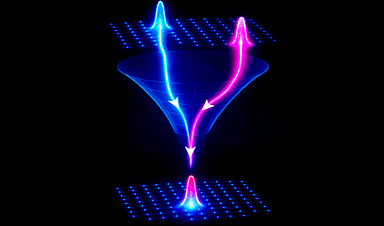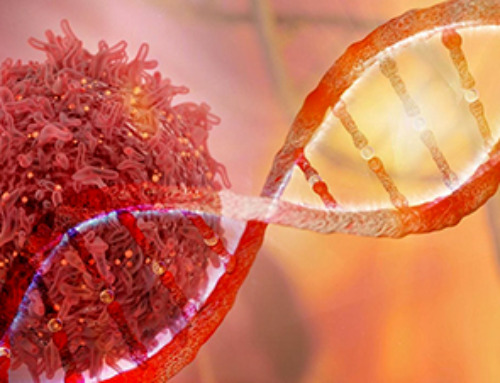| Though they are discrete particles, water molecules flow collectively as liquids, producing streams, waves, whirlpools, and other classic fluid phenomena. | |
| Not so with electricity. While an electric current is also a construct of distinct particles — in this case, electrons — the particles are so small that any collective behavior among them is drowned out by larger influences as electrons pass through ordinary metals. But, in certain materials and under specific conditions, such effects fade away, and electrons can directly influence each other. In these instances, electrons can flow collectively like a fluid. | |
| Now, physicists at MIT and the Weizmann Institute of Science have observed electrons flowing in vortices, or whirlpools — a hallmark of fluid flow that theorists predicted electrons should exhibit, but that has never been seen until now. | |
| “Electron vortices are expected in theory, but there’s been no direct proof, and seeing is believing,” says Leonid Levitov, professor of physics at MIT. “Now we’ve seen it, and it’s a clear signature of being in this new regime, where electrons behave as a fluid, not as individual particles.” |
| The observations, reported in the journal Nature (“Direct observation of vortices in an electron fluid”), could inform the design of more efficient electronics. | |
| “We know when electrons go in a fluid state, [energy] dissipation drops, and that’s of interest in trying to design low-power electronics,” Levitov says. “This new observation is another step in that direction.” | |
| Levitov is a co-author of the new paper, along with Eli Zeldov and others at the Weizmann Institute for Science in Israel and the University of Colorado at Denver. | |
A collective squeeze |
|
| When electricity runs through most ordinary metals and semiconductors, the momenta and trajectories of electrons in the current are influenced by impurities in the material and vibrations among the material’s atoms. These processes dominate electron behavior in ordinary materials. | |
| But theorists have predicted that in the absence of such ordinary, classical processes, quantum effects should take over. Namely, electrons should pick up on each other’s delicate quantum behavior and move collectively, as a viscous, honey-like electron fluid. This liquid-like behavior should emerge in ultraclean materials and at near-zero temperatures. | |
| In 2017, Levitov and colleagues at the University of Manchester reported signatures of such fluid-like electron behavior in graphene, an atom-thin sheet of carbon onto which they etched a thin channel with several pinch points. They observed that a current sent through the channel could flow through the constrictions with little resistance. This suggested that the electrons in the current were able to squeeze through the pinch points collectively, much like a fluid, rather than clogging, like individual grains of sand. | |
| This first indication prompted Levitov to explore other electron fluid phenomena. In the new study, he and colleagues at the Weizmann Institute for Science looked to visualize electron vortices. As they write in their paper, “the most striking and ubiquitous feature in the flow of regular fluids, the formation of vortices and turbulence, has not yet been observed in electron fluids despite numerous theoretical predictions.” | |
Channeling flow |
|
| To visualize electron vortices, the team looked to tungsten ditelluride (WTe2), an ultraclean metallic compound that has been found to exhibit exotic electronic properties when isolated in single-atom-thin, two-dimensional form. | |
| “Tungsten ditelluride is one of the new quantum materials where electrons are strongly interacting and behave as quantum waves rather than particles,” Levitov says. “In addition, the material is very clean, which makes the fluid-like behavior directly accessible.” | |
| The researchers synthesized pure single crystals of tungsten ditelluride, and exfoliated thin flakes of the material. They then used e-beam lithography and plasma etching techniques to pattern each flake into a center channel connected to a circular chamber on either side. They etched the same pattern into thin flakes of gold — a standard metal with ordinary, classical electronic properties. | |
| They then ran a current through each patterned sample at ultralow temperatures of 4.5 kelvins (about -450 degrees Fahrenheit) and measured the current flow at specific points throughout each sample, using a nanoscale scanning superconducting quantum interference device (SQUID) on a tip. This device was developed in Zeldov’s lab and measures magnetic fields with extremely high precision. Using the device to scan each sample, the team was able to observe in detail how electrons flowed through the patterned channels in each material. | |
| The researchers observed that electrons flowing through patterned channels in gold flakes did so without reversing direction, even when some of the current passed through each side chamber before joining back up with the main current. In contrast, electrons flowing through tungsten ditelluride flowed through the channel and swirled into each side chamber, much as water would do when emptying into a bowl. The electrons created small whirlpools in each chamber before flowing back out into the main channel. | |
| “We observed a change in the flow direction in the chambers, where the flow direction reversed the direction as compared to that in the central strip,” Levitov says. “That is a very striking thing, and it is the same physics as that in ordinary fluids, but happening with electrons on the nanoscale. That’s a clear signature of electrons being in a fluid-like regime.” | |
| The group’s observations are the first direct visualization of swirling vortices in an electric current. The findings represent an experimental confirmation of a fundamental property in electron behavior. They may also offer clues to how engineers might design low-power devices that conduct electricity in a more fluid, less resistive manner. |
News
New nanomedicine wipes out leukemia in animal study
In a promising advance for cancer treatment, Northwestern University scientists have re-engineered the molecular structure of a common chemotherapy drug, making it dramatically more soluble and effective and less toxic. In the new study, [...]
Mystery Solved: Scientists Find Cause for Unexplained, Deadly Diseases
A study reveals that a protein called RPA is essential for maintaining chromosome stability by stimulating telomerase. New findings from the University of Wisconsin-Madison suggest that problems with a key protein that helps preserve chromosome stability [...]
Nanotech Blocks Infection and Speed Up Chronic Wound Recovery
A new nanotech-based formulation using quercetin and omega-3 fatty acids shows promise in halting bacterial biofilms and boosting skin cell repair. Scientists have developed a nanotechnology-based treatment to fight bacterial biofilms in wound infections. The [...]
Researchers propose five key questions for effective adoption of AI in clinical practice
While Artificial Intelligence (AI) can be a powerful tool that physicians can use to help diagnose their patients and has great potential to improve accuracy, efficiency and patient safety, it has its drawbacks. It [...]
Advancements and clinical translation of intelligent nanodrugs for breast cancer treatment
A comprehensive review in "Biofunct. Mater." meticulously details the most recent advancements and clinical translation of intelligent nanodrugs for breast cancer treatment. This paper presents an exhaustive overview of subtype-specific nanostrategies, the clinical benefits [...]
It’s Not “All in Your Head”: Scientists Develop Revolutionary Blood Test for Chronic Fatigue Syndrome
A 96% accurate blood test for ME/CFS could transform diagnosis and pave the way for future long COVID detection. Researchers from the University of East Anglia and Oxford Biodynamics have created a highly accurate [...]
How Far Can the Body Go? Scientists Find the Ultimate Limit of Human Endurance
Even the most elite endurance athletes can’t outrun biology. A new study finds that humans hit a metabolic ceiling at about 2.5 times their resting energy burn. When ultra-runners take on races that last [...]
World’s Rivers “Overdosing” on Human Antibiotics, Study Finds
Researchers estimate that approximately 8,500 tons of antibiotics enter river systems each year after passing through the human body and wastewater treatment processes. Rivers spanning millions of kilometers across the globe are contaminated with [...]
Yale Scientists Solve a Century-Old Brain Wave Mystery
Yale scientists traced gamma brain waves to thalamus-cortex interactions. The discovery could reveal how brain rhythms shape perception and disease. For more than a century, scientists have observed rhythmic waves of synchronized neuronal activity [...]
Can introducing peanuts early prevent allergies? Real-world data confirms it helps
New evidence from a large U.S. primary care network shows that early peanut introduction, endorsed in 2015 and 2017 guidelines, was followed by a marked decline in clinician-diagnosed peanut and overall food allergies among [...]
Nanoparticle blueprints reveal path to smarter medicines
Lipid nanoparticles (LNPs) are the delivery vehicles of modern medicine, carrying cancer drugs, gene therapies and vaccines into cells. Until recently, many scientists assumed that all LNPs followed more or less the same blueprint, [...]
How nanomedicine and AI are teaming up to tackle neurodegenerative diseases
When I first realized the scale of the challenge posed by neurodegenerative diseases, such as Alzheimer's, Parkinson's disease and amyotrophic lateral sclerosis (ALS), I felt simultaneously humbled and motivated. These disorders are not caused [...]
Self-Organizing Light Could Transform Computing and Communications
USC engineers have demonstrated a new kind of optical device that lets light organize its own route using the principles of thermodynamics. Instead of relying on switches or digital control, the light finds its own [...]
Groundbreaking New Way of Measuring Blood Pressure Could Save Thousands of Lives
A new method that improves the accuracy of interpreting blood pressure measurements taken at the ankle could be vital for individuals who are unable to have their blood pressure measured on the arm. A newly developed [...]
Scientist tackles key roadblock for AI in drug discovery
The drug development pipeline is a costly and lengthy process. Identifying high-quality "hit" compounds—those with high potency, selectivity, and favorable metabolic properties—at the earliest stages is important for reducing cost and accelerating the path [...]
Nanoplastics with environmental coatings can sneak past the skin’s defenses
Plastic is ubiquitous in the modern world, and it's notorious for taking a long time to completely break down in the environment - if it ever does. But even without breaking down completely, plastic [...]





















